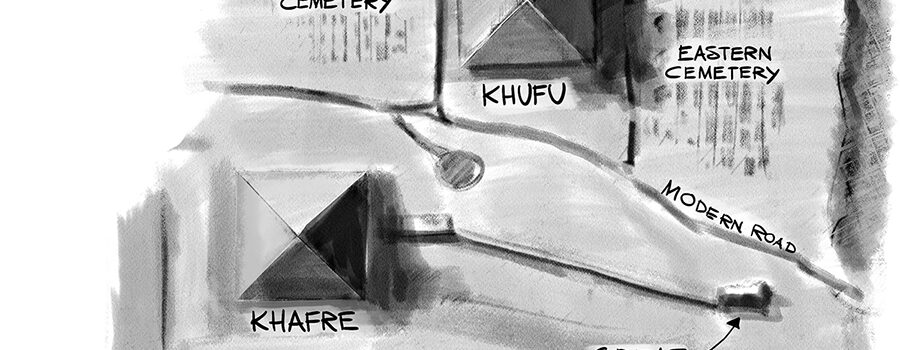The Golden Ellipse, Book One in The Powers That Be Trilogy, paints a unique portrait of Pharaoh Khufu’s formative years, thereby casting his infamous and confounding pyramid in a new light. Perhaps the Great Pyramid was much more than a power-mad king’s vanity project after all.
Khufu (Cheops) followed his father, Sneferu, becoming the second pharaoh of Egypt’s Fourth Dynasty, though accusations of an illegitimate birthright plagued his reign. The Greek historian Herodotus described Khufu as bringing “every kind of evil” onto the peaceful, industrious Egyptian population, transforming his kingdom into a brutal and authoritarian slave state.[1] Moreover, his Great Pyramid—the Seventh Wonder of the World—undoubtedly benefitted from his father’s botched attempts at pyramid building.
Sneferu’s pyramidical aspirations culminated in a malformed structure known today as the Red, or Bent, Pyramid.[2] Despite its rank as the fourth largest pyramid in Egypt, tourists and academics of all stripes ignore its crumbling perimeter in favor of pouring over every rock and crevice on the Giza Plateau, transfixed by multitudinous conundrums surrounding Khufu’s pyramid.
The elemental precision of the Giza pyramids indicates that by the time Khufu directed thousands of slaves to erect his grand final resting place, engineers, surveyors, and mathematicians resolved logistical and practical riddles encountered during Sneferu’s crude pyramid undertakings.
Notwithstanding the obvious, the Great Pyramid exists; however, no historical records detail how an ancient people with only rudimentary tools and the broad shoulders of an enslaved citizenry achieved architectural mastery and precise alignment with the heavens.
While it is almost certain each pyramids’ primary purpose was the final and eternal repose of their respective pharaonic souls, no evidence exists of Khufu’s internment within his namesake structure. In fact, in addition to Herodotus’ description of Khufu’s loathsomeness, Book 2 of Historia also includes accounts stating the pharaoh’s burial location was an island tomb in the Nile River.[1] Further muddying the waters, so to speak, scant physical evidence correlating to Khufu has ever been found, in stark contrast to other Egyptian rulers, such as the omnipresent King Tut. The only dimensional object bearing Khufu’s likeness is a 3-inch-tall ivory statue discovered by Sir William Petrie in 1903.[4]
This is my first post in a series exploring the historical people, places, and events underlying the mythology of The Golden Ellipse and its sweeping narrative spanning eons in time and into the future.
Read The Golden Ellipse and draw your conclusions on the power and purpose behind the Great Pyramid. A good indicator of whether art is successful beyond how it makes you feel is does it make you think. I welcome comments and replies, academic or otherwise, on this post and a host of upcoming blog posts on a range of topics from my novel. Cheers and look to the skies.
References
- https://www.gutenberg.org/files/2131/2131-h/2131-h.htm
- https://blog.world-mysteries.com/mystic-places/red-bent-pyramid-dashur/
- https://penelope.uchicago.edu/Thayer/E/Roman/Texts/Strabo/17A3*.html
- https://abydos.org/blog/2019/5/17/happy-museum-day-king-khufu








